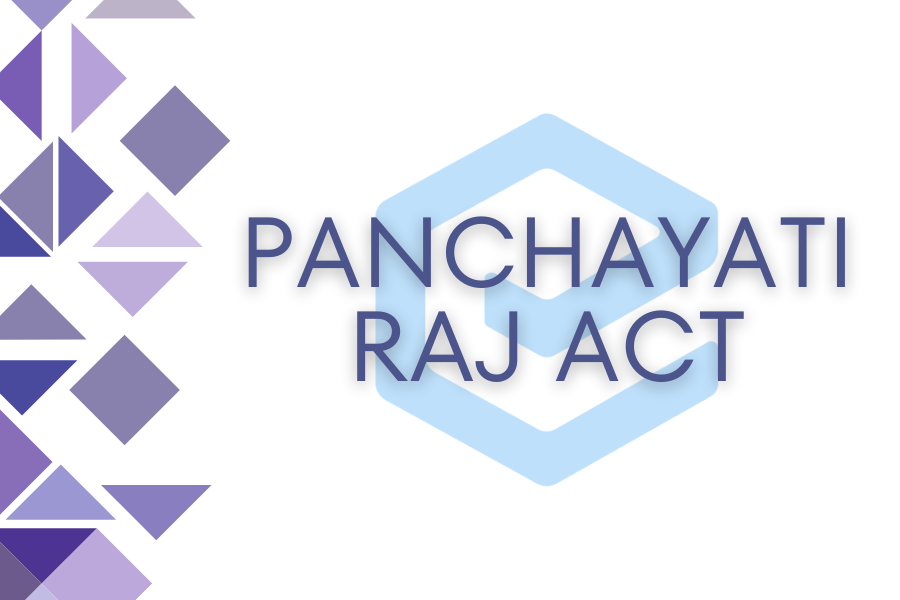
The Panchayati Raj Act, a pivotal legislation in the realm of local governance in India, stands as a beacon of grassroots democracy and decentralization. Enacted in 1992, this landmark legislation aimed at empowering rural communities by establishing a three-tiered system of local self-government, comprising gram panchayats at the village level, panchayat samitis at the intermediate level, and zila parishads at the district level. Rooted in the principles of participatory democracy, the Panchayati Raj Act sought to devolve powers, functions, and responsibilities to these elected bodies, thereby fostering community participation, socio-economic development, and effective delivery of public services at the grassroots level. Over the years, it has played a pivotal role in democratizing rural governance, promoting social justice, and enhancing the inclusivity of decision-making processes in India’s vast and diverse rural landscape.
Panchayati Raj is a system of local self-government in India that aims to promote grassroots democracy and decentralize power. Here’s an overview of the Panchayati Raj system and its historical development:
Contents
Historical Roots:
- The concept of local self-government has ancient roots in India. In the Vedic period, Sabhas (assemblies) and Samitis (councils) were mentioned in texts like the Rigveda.
- These local governing institutions later evolved into Panchayats, which were responsible for managing village affairs, including law enforcement and dispute resolution.
Constitutional Framework:
- The Indian Constitution, upon its adoption in 1950, did not initially include a provision for local self-government.
- The concept of local self-government was introduced later through Article 40 of the Directive Principles of State Policy (DPSP). However, this provision was not mandatory, and its implementation varied across states.
Panchayati Raj Act:
- A more comprehensive constitutional framework for Panchayati Raj was needed to ensure uniformity and effective implementation across the country.
- In 1989, the 64th Constitutional Amendment Bill related to Panchayati Raj bodies was introduced by the Rajiv Gandhi government but was blocked by opposition parties.
- Subsequently, in 1992, the 73rd and 74th Constitutional Amendment Bills were passed under the Narasimha Rao government.
- The 73rd Amendment pertains to Panchayats (rural local self-government), while the 74th Amendment pertains to Municipalities (urban local self-government).
- These amendments added the Eleventh Schedule (for Panchayats) and the Twelfth Schedule (for Municipalities) to the Constitution. These schedules list the subjects and functions to be handled by Panchayats and Municipalities, respectively.
Key Features of Panchayati Raj:
- The Panchayati Raj system in India is structured into three tiers: Gram Panchayat at the village level, Panchayat Samiti at the intermediate level, and Zila Parishad at the district level.
- The system aims to promote local self-governance and empower communities by involving them in decision-making processes at the grassroots level.
- Panchayats have authority over various subjects, including rural development, agriculture, health, education, and local infrastructure.
- Elections to Panchayats are held regularly, ensuring representation of people at these local government bodies.
- The system helps in addressing the unique developmental needs of villages and promoting social and economic progress at the local level.
The Panchayati Raj system plays a crucial role in promoting grassroots democracy, decentralization of power, and local development in India. It reflects the commitment of the Indian government to democratic principles and decentralized governance.
FAQs
Q: What is the Panchayati Raj Act?
The Panchayati Raj Act is a legislation enacted by the government of India to establish a decentralized system of local self-governance in rural areas. It aims to empower local communities by giving them the authority to manage their own affairs, including planning and implementing development projects.
Q: What are the key features of the Panchayati Raj Act?
- Three-tier system: The Act establishes a three-tier system of Panchayats at the village, intermediate (block), and district levels.
- Democratic elections: Panchayat members are elected through regular democratic elections, ensuring representation from all sections of society.
- Devolution of powers: The Act delegates various administrative, financial, and planning powers to the Panchayats, enabling them to make decisions on local issues.
- Reservation for marginalized groups: Provisions are made for reservation of seats in Panchayats for women, Scheduled Castes (SCs), Scheduled Tribes (STs), and other marginalized communities to ensure their participation in local governance.
Q: What is the significance of the Panchayati Raj Act?
- Grassroots democracy: The Act promotes grassroots democracy by involving local communities in decision-making processes.
- Rural development: It facilitates the effective implementation of rural development programs and ensures that resources are allocated according to local priorities.
- Empowerment of marginalized groups: Through reservation of seats, the Act empowers marginalized groups by providing them with a platform to voice their concerns and participate in decision-making.
Q: How has the Panchayati Raj Act evolved over time?
- Constitutional recognition: The 73rd Amendment Act of 1992 provided constitutional status to Panchayats, ensuring their existence and empowerment.
- Strengthening of institutions: Over the years, various amendments and reforms have been made to strengthen the functioning of Panchayats and enhance their effectiveness in local governance.
- Capacity building: Efforts have been made to build the capacity of Panchayat members and officials through training programs and capacity-building initiatives.
Q: What are the challenges faced by the implementation of the Panchayati Raj Act?
- Financial constraints: Panchayats often face financial constraints, limiting their ability to undertake development projects and deliver basic services.
- Capacity issues: Many Panchayats lack the necessary administrative and technical capacity to effectively manage their responsibilities.
- Political interference: In some cases, political interference hampers the functioning of Panchayats, undermining their autonomy and effectiveness.
In case you still have your doubts, contact us on 9811333901.
For UPSC Prelims Resources, Click here
For Daily Updates and Study Material:
Join our Telegram Channel – Edukemy for IAS
- 1. Learn through Videos – here
- 2. Be Exam Ready by Practicing Daily MCQs – here
- 3. Daily Newsletter – Get all your Current Affairs Covered – here
- 4. Mains Answer Writing Practice – here

